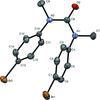issue contents
February 2018 issue

Cover illustration: Over the past few years, metformin hydrochloride (1,1-dimethylbiguanide hydrochloride) has been the most commonly used drug for the first-line treatment of type 2 diabetes. On the other hand, acetylsalicylic acid, which is one of the most used general pain-relieving drugs, has been associated with copper in the form of copper acetylsalicylate to treat rheumatoid arthritis and thromboembolic diseases. The synthesis and crystal structure of a new CuII complex that contains both active pharmaceutical ingredients chelating to the central metal cation, namely neutral metformin and the salicylate dianion, is reported. The hydrous complex (metformin-![[kappa]](/logos/entities/kappa_rmgif.gif) 2N,N')(salicylato-
2N,N')(salicylato-![[kappa]](/logos/entities/kappa_rmgif.gif) 2O,O')copper(II) trihydrate [systematic name: (1,1-dimethylbiguanide-
2O,O')copper(II) trihydrate [systematic name: (1,1-dimethylbiguanide-![[kappa]](/logos/entities/kappa_rmgif.gif) 2N2,N4)(2-oxidobenzoato-
2N2,N4)(2-oxidobenzoato-![[kappa]](/logos/entities/kappa_rmgif.gif) 2O,O')copper(II) trihydrate] was synthesized electrolytically from an ethanolic solution of metformin hydrochloride, acetylsalicylic acid, Pepto-Bismol and a copper sacrificial anode. Diffraction data were collected at 0.56 Å resolution, allowing the accurate determination of H-atom positions in the neutral metformin ligand. See: Gutiérrez Ojeda, Salazar Kuri, Bernès & Pérez-Benítez [IUCrData (2017). 3, x180180].
2O,O')copper(II) trihydrate] was synthesized electrolytically from an ethanolic solution of metformin hydrochloride, acetylsalicylic acid, Pepto-Bismol and a copper sacrificial anode. Diffraction data were collected at 0.56 Å resolution, allowing the accurate determination of H-atom positions in the neutral metformin ligand. See: Gutiérrez Ojeda, Salazar Kuri, Bernès & Pérez-Benítez [IUCrData (2017). 3, x180180].
inorganic compounds


 access
access

 access
access

 access
access

 access
accessmetal-organic compounds


 access
accessorganic compounds


 access
access

 access
access

 access
access

 access
access

 access
access

 access
access

 access
access

 access
access

 access
access

 access
access

 access
access

 access
access

 access
access

 access
access

 access
access

 journal menu
journal menu































![[publCIF]](/logos/authorchecklist11.gif)





